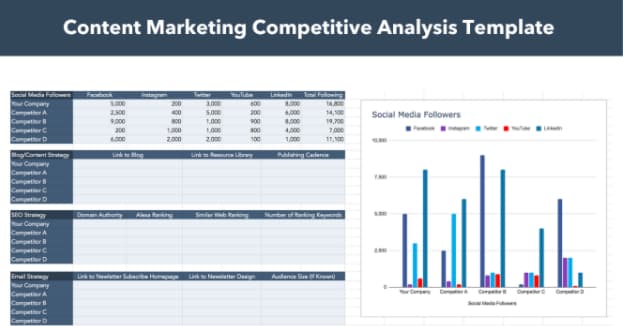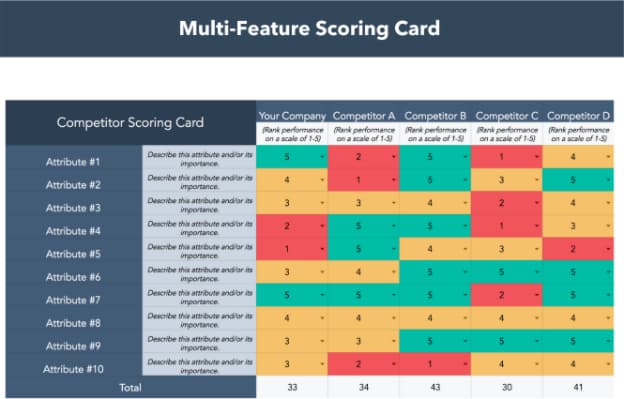Competition is essential for growth, but only when a business properly evaluates its competitors and betters itself to keep up. Even in marketing, analyzing the competition is healthy and can help inspire you to learn and adapt the business to better meet consumer needs.
Part of the way to do this is by understanding direct and indirect competition and how each can impact your work. Once you know the differences, you can determine how to best identify and evaluate your competitors — both direct and indirect.
What is direct competition?
When you think of a marketing competitor, you likely think of your direct competitors. Direct competitors are other businesses offering the same services for the same client needs in the same market as you.
So, let’s say your marketing firm primarily works with restaurants in the western U.S. There are certainly other firms focused on restaurant marketing specifically in the western U.S., and those firms would be your direct competition.
Even the smallest markets will have direct competition, which is important to prevent monopolies.
Direct Competition Examples
There are many examples of direct competition. McDonald’s, Wendy’s, and Burger King are all direct competitors. Similarly, consider the infamous fast-food chicken sandwich wars, when major restaurant chains like Popeyes, KFC, Wendy’s, Zaxby’s, and more all launched chicken sandwiches to appeal to the same consumer base across the U.S..
Competition doesn’t just apply to huge, national or international brands. Two women’s fashion boutiques in a small, rural town are also direct competitors.
Digital companies also see direct competition. For example, Instagram and Snapchat offer very similar features, like disappearing stories and direct messaging, to their target audiences.
Indirect Competition Examples
Let’s say we have a client base in a small town. The customers are hungry, and often frequent the main drag to have dinner. Here, there are four major restaurants — all of which offer different types of food. Although the products they offer are different, the restaurants all stand for the same purpose: to feed hungry clientele in the town.
Similarly, consider a client who needs to buy gifts for a birthday party. One store sells clothing. A store across the street sells jewelry. Despite the different products, the two stores are competing for the same customer.
Direct and Indirect Competition in Marketing
When it comes to marketing, knowing your direct and indirect competition can help you improve your campaigns and even reach new audiences.
The aforementioned chicken sandwich wars are a great example here. Popeyes launched its highly touted fried chicken sandwich with a powerful marketing campaign. Direct competitors — other fast-food restaurants that sell chicken sandwiches — were able to use marketing to showcase their own entries into the so-called competition.
The result? The chicken sandwich wars have been heavily covered by major media for the past couple years. Customers have lined up in droves at various fast food restaurants to try the latest and claimed-to-be-greatest chicken sandwiches.
On the other hand, analyzing your indirect competition can help marketers tap into a wider audience. If you know people shopping for gifts are choosing between your store and similar shops that offer different products, you can create campaigns to draw in those customers. Digitally, indirect competitors might be targeting the same keywords, and understanding that can help boost SEO and get your business to the top of the search engine results page (SERP).
1. Customer Feedback
One quick way to identify your competitors is to ask your current clients or potential clients. For example, if you have a potential customer come in with questions about your products or services, ask them some other businesses they are considering for this purchase. Send feedback surveys that ask customers what other brands they were considering and why they went with yours.
2. Market Research
This requires some digging on your end. If you have a brick-and-mortar, you’ll need to review similar stores, their websites, and their social media to get a better idea of their businesses. Customer surveys can also fall into the market research category.
3. Social Media
Many people share their purchasing experiences on social media and forum websites like Reddit. Check out the recommendations people are sharing for products or services that you also sell to help identify top competitors in your market.
4. Keyword Research
For indirect competitors, turn to keyword research. You can use the keywords you are targeting to identify other businesses that are targeting the same keywords, and ultimately, the same top spot on the SERP and the same audience.
5. Review the SERP
Speaking of the SERP, it can also be a handy tool to identify your competitors. Search your keywords to find what businesses are ranking highly for these keywords to see your indirect competitors.
Tracking and Analyzing Competitors
Now you know the differences between direct and indirect competitors, and you’ve narrowed down a list of both related to your business. What next?
It’s time to conduct a competitive analysis, which will help you improve your own business strategies when comparing them to your competitors.
There are several items to include in a competitive analysis: direct and indirect competitors, products/services sold, competitors’ sales tactics, pricing and sales, marketing and content strategies, and social media and websites.
This comprehensive data will give you a better idea of how your competitors are operating on every level, from the products they sell to their customer service, all online and offline.
Researching competitors, products, services, keywords, and marketing tactics adds up to a lot of data that needs sorted and organized, so HubSpot’s competitive analysis templates can make light work of these tasks.
 For example, this Content Marketing Competitive Analysis Template can help you track competitors’ strategies across social, blogs, email, and SEO.
For example, this Content Marketing Competitive Analysis Template can help you track competitors’ strategies across social, blogs, email, and SEO.
 This multi-feature scorecard will allow you to compare your company to its competitors based on a number of customizable attributes.
This multi-feature scorecard will allow you to compare your company to its competitors based on a number of customizable attributes.
There are many different templates to consider when creating a visual competitive analysis, so find the one that best suits your needs. You might find using multiple for different comparisons can also be useful.
Use Direct and Indirect Competition Analysis to Your Benefit
A little healthy competition never hurt anybody, but you have to know how to play the game. By identifying and analyzing your competitors, you can get a leg up on the competition by improving your marketing strategies, focusing on your target audience, and reaching potential new clients.
Direct vs. Indirect Competition, Explained was originally posted by Local Sign Company Irvine, Ca. https://goo.gl/4NmUQV https://goo.gl/bQ1zHR http://www.pearltrees.com/anaheimsigns
![→ Download Now: Market Research Templates [Free Kit]](https://no-cache.hubspot.com/cta/default/53/6ba52ce7-bb69-4b63-965b-4ea21ba905da.png)

No comments:
Post a Comment